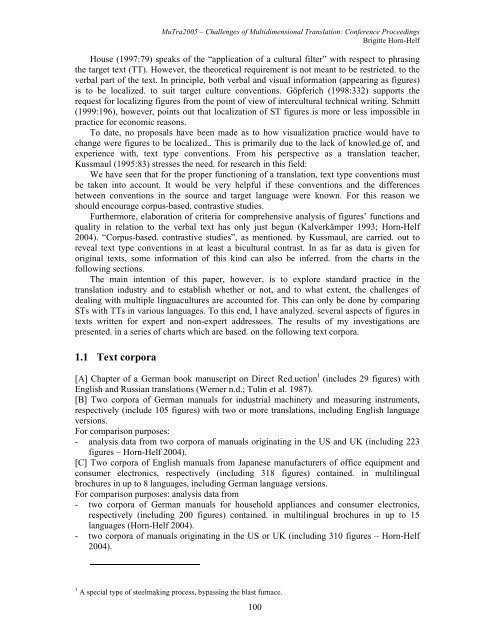Proceedings - Translation Concepts
Proceedings - Translation Concepts
Proceedings - Translation Concepts
Create successful ePaper yourself
Turn your PDF publications into a flip-book with our unique Google optimized e-Paper software.
MuTra2005 – Challenges of Multidimensional <strong>Translation</strong>: Conference <strong>Proceedings</strong><br />
Brigitte Horn-Helf<br />
House (1997:79) speaks of the “application of a cultural filter” with respect to phrasing<br />
the target text (TT). However, the theoretical requirement is not meant to be restricted. to the<br />
verbal part of the text. In principle, both verbal and visual information (appearing as figures)<br />
is to be localized. to suit target culture conventions. Göpferich (1998:332) supports the<br />
request for localizing figures from the point of view of intercultural technical writing. Schmitt<br />
(1999:196), however, points out that localization of ST figures is more or less impossible in<br />
practice for economic reasons.<br />
To date, no proposals have been made as to how visualization practice would have to<br />
change were figures to be localized.. This is primarily due to the lack of knowled.ge of, and<br />
experience with, text type conventions. From his perspective as a translation teacher,<br />
Kussmaul (1995:83) stresses the need. for research in this field:<br />
We have seen that for the proper functioning of a translation, text type conventions must<br />
be taken into account. It would be very helpful if these conventions and the differences<br />
between conventions in the source and target language were known. For this reason we<br />
should encourage corpus-based. contrastive studies.<br />
Furthermore, elaboration of criteria for comprehensive analysis of figures’ functions and<br />
quality in relation to the verbal text has only just begun (Kalverkämper 1993; Horn-Helf<br />
2004). “Corpus-based. contrastive studies”, as mentioned. by Kussmaul, are carried. out to<br />
reveal text type conventions in at least a bicultural contrast. In as far as data is given for<br />
original texts, some information of this kind can also be inferred. from the charts in the<br />
following sections.<br />
The main intention of this paper, however, is to explore standard practice in the<br />
translation industry and to establish whether or not, and to what extent, the challenges of<br />
dealing with multiple linguacultures are accounted for. This can only be done by comparing<br />
STs with TTs in various languages. To this end, I have analyzed. several aspects of figures in<br />
texts written for expert and non-expert addressees. The results of my investigations are<br />
presented. in a series of charts which are based. on the following text corpora.<br />
1.1 Text corpora<br />
[A] Chapter of a German book manuscript on Direct Red.uction 1 (includes 29 figures) with<br />
English and Russian translations (Werner n.d.; Tulin et al. 1987).<br />
[B] Two corpora of German manuals for industrial machinery and measuring instruments,<br />
respectively (include 105 figures) with two or more translations, including English language<br />
versions.<br />
For comparison purposes:<br />
- analysis data from two corpora of manuals originating in the US and UK (including 223<br />
figures – Horn-Helf 2004).<br />
[C] Two corpora of English manuals from Japanese manufacturers of office equipment and<br />
consumer electronics, respectively (including 318 figures) contained. in multilingual<br />
brochures in up to 8 languages, including German language versions.<br />
For comparison purposes: analysis data from<br />
- two corpora of German manuals for household appliances and consumer electronics,<br />
respectively (including 200 figures) contained. in multilingual brochures in up to 15<br />
languages (Horn-Helf 2004).<br />
- two corpora of manuals originating in the US or UK (including 310 figures – Horn-Helf<br />
2004).<br />
1 A special type of steelmaking process, bypassing the blast furnace.<br />
100
















